Risk Management Analysis: Safety Case Regime and Case Study
VerifiedAdded on 2020/03/07
|12
|2916
|34
Report
AI Summary
This report delves into the intricacies of risk management and the safety case regime, crucial elements in ensuring safety and mitigating risks in various industries. It explores different approaches to risk management, emphasizing the identification, analysis, and mitigation of uncertainties. The report highlights the key features of the safety case regime, including the duty holder's responsibilities, continuous risk reduction through the ALARP principle, adaptability, workforce participation, and regulatory assessment. Furthermore, the report examines the application of the safety case regime in preventing major accidents, using the Piper Alpha oil and gas platform explosion as a case study. It discusses the safety measures implemented before and after the regime's introduction, underscoring the importance of proactive safety protocols and continuous improvement. The report underscores the importance of risk management, safety case regimes and the role they play in safeguarding operations and preventing catastrophic incidents.
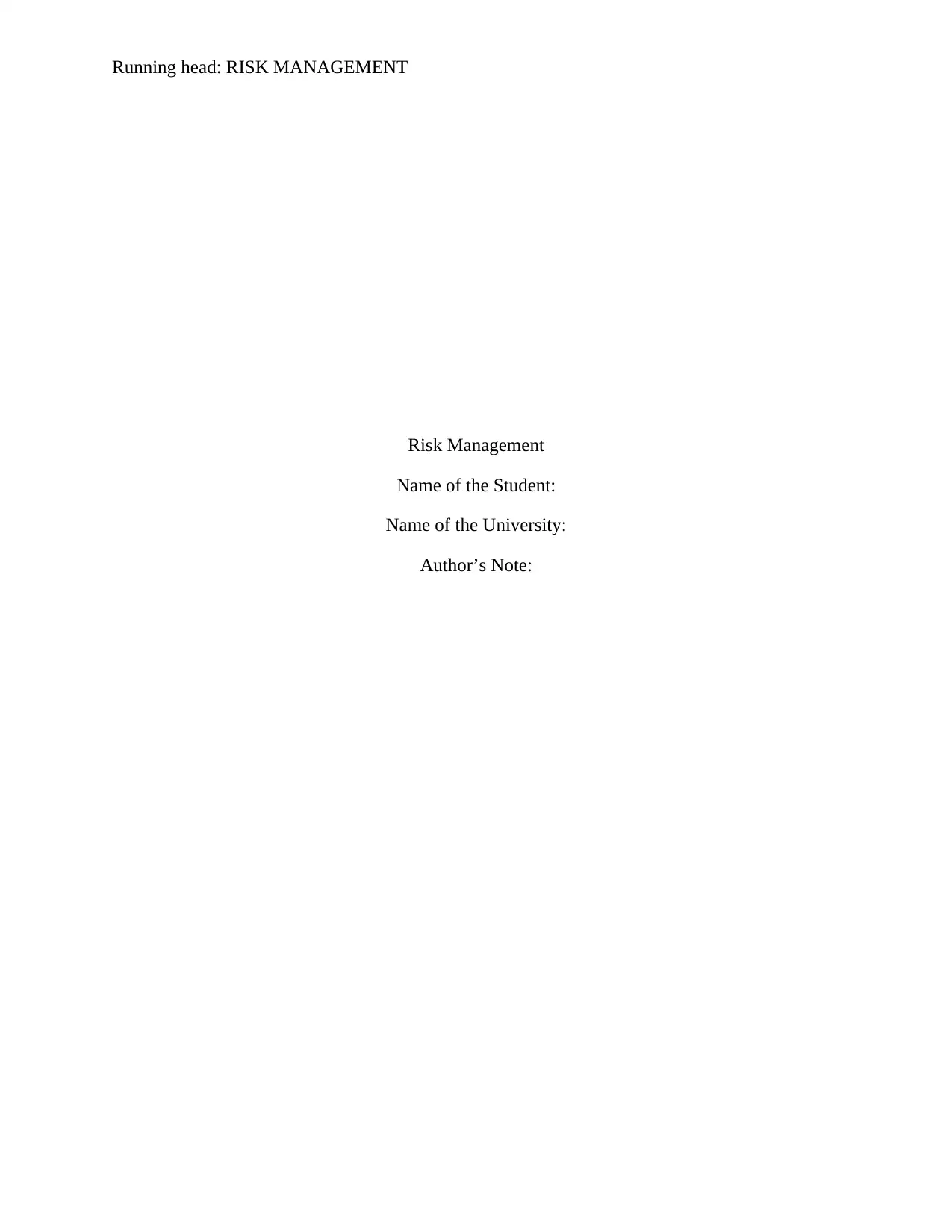
Running head: RISK MANAGEMENT
Risk Management
Name of the Student:
Name of the University:
Author’s Note:
Risk Management
Name of the Student:
Name of the University:
Author’s Note:
Paraphrase This Document
Need a fresh take? Get an instant paraphrase of this document with our AI Paraphraser
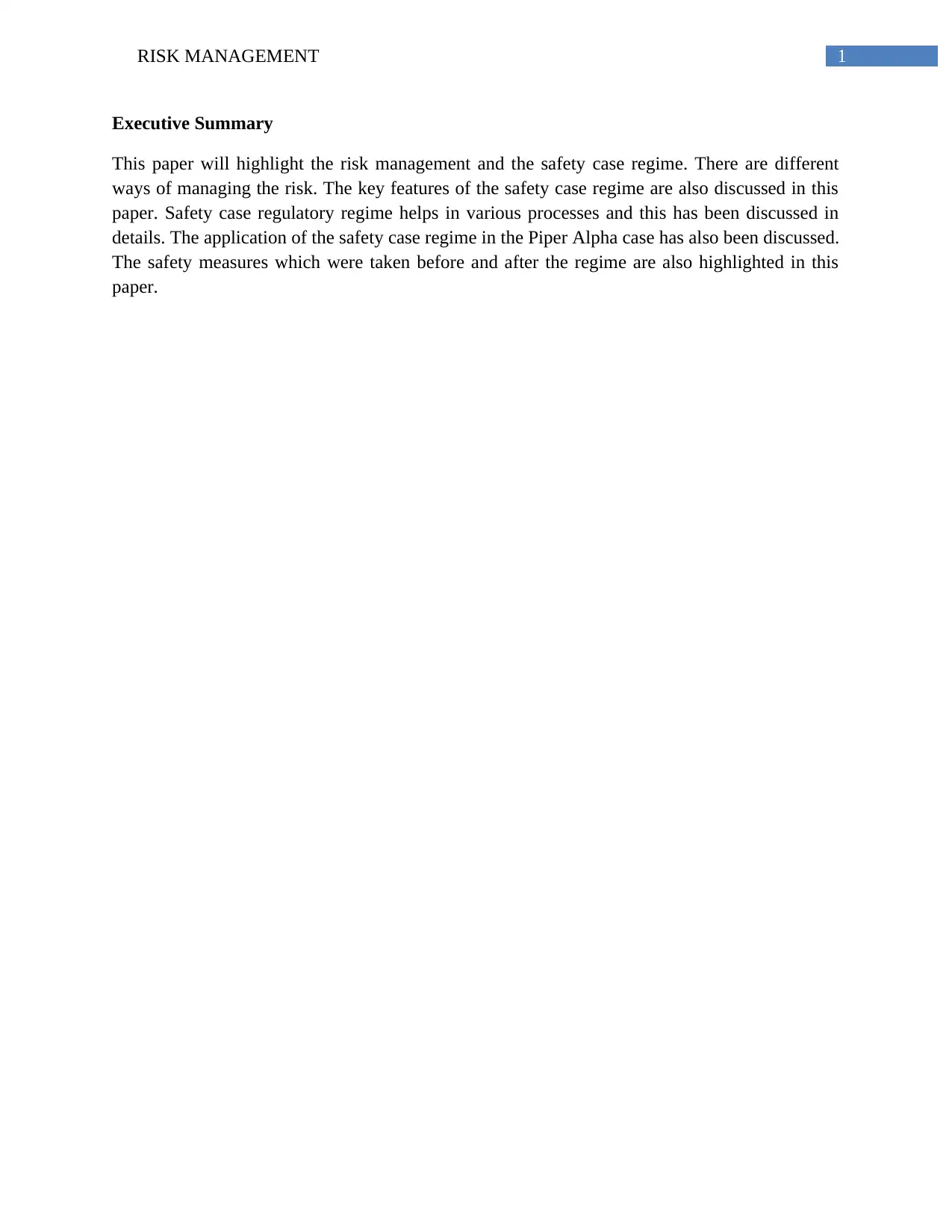
1RISK MANAGEMENT
Executive Summary
This paper will highlight the risk management and the safety case regime. There are different
ways of managing the risk. The key features of the safety case regime are also discussed in this
paper. Safety case regulatory regime helps in various processes and this has been discussed in
details. The application of the safety case regime in the Piper Alpha case has also been discussed.
The safety measures which were taken before and after the regime are also highlighted in this
paper.
Executive Summary
This paper will highlight the risk management and the safety case regime. There are different
ways of managing the risk. The key features of the safety case regime are also discussed in this
paper. Safety case regulatory regime helps in various processes and this has been discussed in
details. The application of the safety case regime in the Piper Alpha case has also been discussed.
The safety measures which were taken before and after the regime are also highlighted in this
paper.
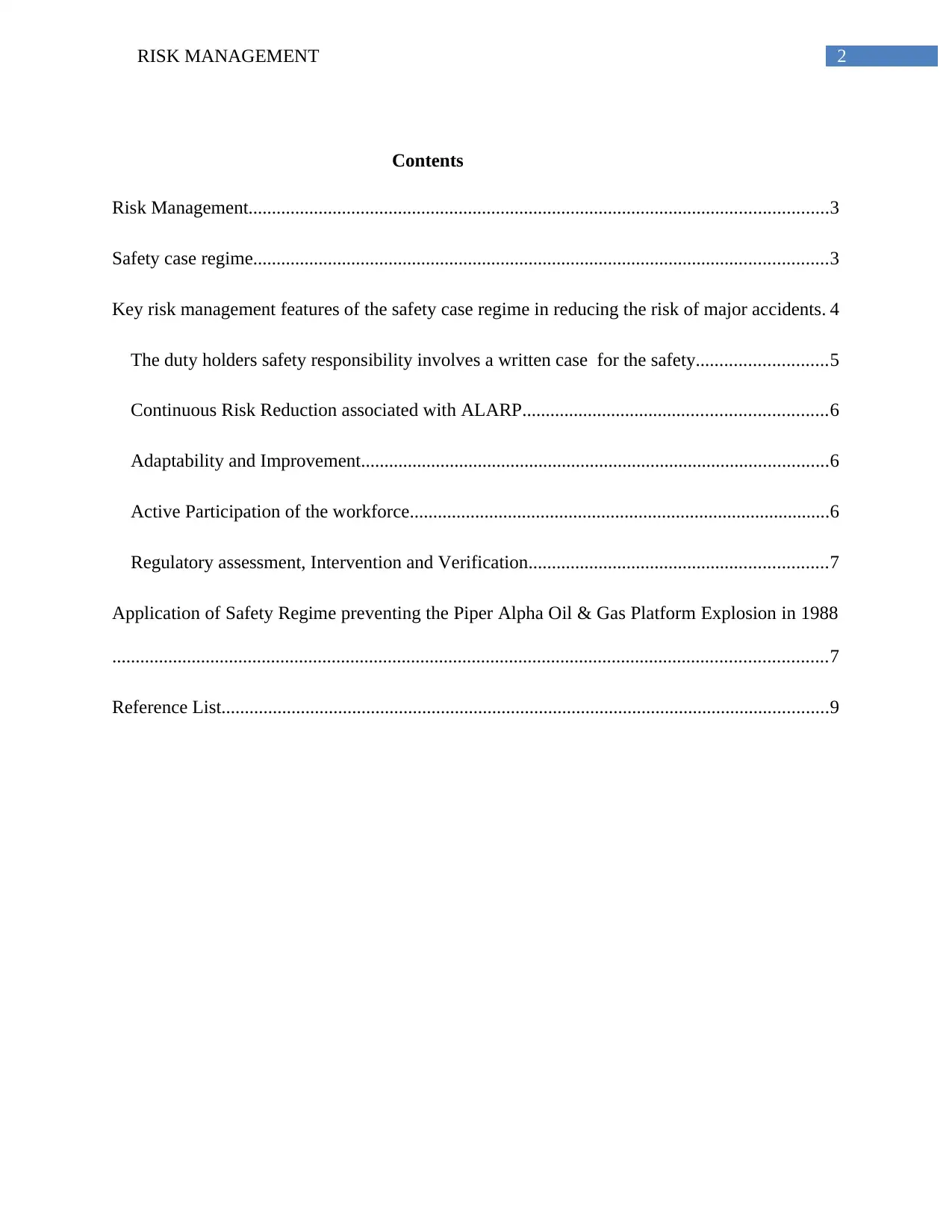
2RISK MANAGEMENT
Contents
Risk Management............................................................................................................................3
Safety case regime...........................................................................................................................3
Key risk management features of the safety case regime in reducing the risk of major accidents. 4
The duty holders safety responsibility involves a written case for the safety............................5
Continuous Risk Reduction associated with ALARP.................................................................6
Adaptability and Improvement....................................................................................................6
Active Participation of the workforce..........................................................................................6
Regulatory assessment, Intervention and Verification................................................................7
Application of Safety Regime preventing the Piper Alpha Oil & Gas Platform Explosion in 1988
.........................................................................................................................................................7
Reference List..................................................................................................................................9
Contents
Risk Management............................................................................................................................3
Safety case regime...........................................................................................................................3
Key risk management features of the safety case regime in reducing the risk of major accidents. 4
The duty holders safety responsibility involves a written case for the safety............................5
Continuous Risk Reduction associated with ALARP.................................................................6
Adaptability and Improvement....................................................................................................6
Active Participation of the workforce..........................................................................................6
Regulatory assessment, Intervention and Verification................................................................7
Application of Safety Regime preventing the Piper Alpha Oil & Gas Platform Explosion in 1988
.........................................................................................................................................................7
Reference List..................................................................................................................................9
⊘ This is a preview!⊘
Do you want full access?
Subscribe today to unlock all pages.

Trusted by 1+ million students worldwide

3RISK MANAGEMENT
Risk Management
Risk management is the process of identification, acceptance, analysis and mitigation of
the various kinds of uncertainties which is related with the decision making processes. An entity
has to get exposed to various kinds of financial risks when he makes an investment. The
quantum and the type of risk are associated with the type of instrument involved in the process.
In order to control and minimize suck risks, the investors and the mangers practices risk
management (Hopkins 2013). It is vital to give importance to risk management when making any
kind of investments because there might be sudden financial turmoil in any economy. The
organizations and the companies must also understand the various risks that might arise and they
must readily accept them. The internal auditors, external auditors, board of directors and the
management authority of the company plays various roles in managing the risk. There are
various ways of managing risks such as sharing the risks with others, using derivatives and
hedges, buying insurance and trying to avoid risky situations (Hayes 2014).
Safety case regime
There are certain facilities which are associated in handling the large quantities of
dangerous goods and which have the risk for creating major incidents, the consequences of those
accidents may lead to death, damage of property or injury. Such a facility in the generation of
those incidents referred to as MHF. Only some rare accidents which may lead to such
catastrophic situations and it gets very less attention in comparison with the operational issues.
The aim of MHF is almost similar to the onshore and offshore facilities that exist in Europe and
the offshore gas and oil operation of Australia. Safety case regime is an important regulatory
initiative which aims to address these issues. The safety case issue must also try to lower OHS
Risk Management
Risk management is the process of identification, acceptance, analysis and mitigation of
the various kinds of uncertainties which is related with the decision making processes. An entity
has to get exposed to various kinds of financial risks when he makes an investment. The
quantum and the type of risk are associated with the type of instrument involved in the process.
In order to control and minimize suck risks, the investors and the mangers practices risk
management (Hopkins 2013). It is vital to give importance to risk management when making any
kind of investments because there might be sudden financial turmoil in any economy. The
organizations and the companies must also understand the various risks that might arise and they
must readily accept them. The internal auditors, external auditors, board of directors and the
management authority of the company plays various roles in managing the risk. There are
various ways of managing risks such as sharing the risks with others, using derivatives and
hedges, buying insurance and trying to avoid risky situations (Hayes 2014).
Safety case regime
There are certain facilities which are associated in handling the large quantities of
dangerous goods and which have the risk for creating major incidents, the consequences of those
accidents may lead to death, damage of property or injury. Such a facility in the generation of
those incidents referred to as MHF. Only some rare accidents which may lead to such
catastrophic situations and it gets very less attention in comparison with the operational issues.
The aim of MHF is almost similar to the onshore and offshore facilities that exist in Europe and
the offshore gas and oil operation of Australia. Safety case regime is an important regulatory
initiative which aims to address these issues. The safety case issue must also try to lower OHS
Paraphrase This Document
Need a fresh take? Get an instant paraphrase of this document with our AI Paraphraser
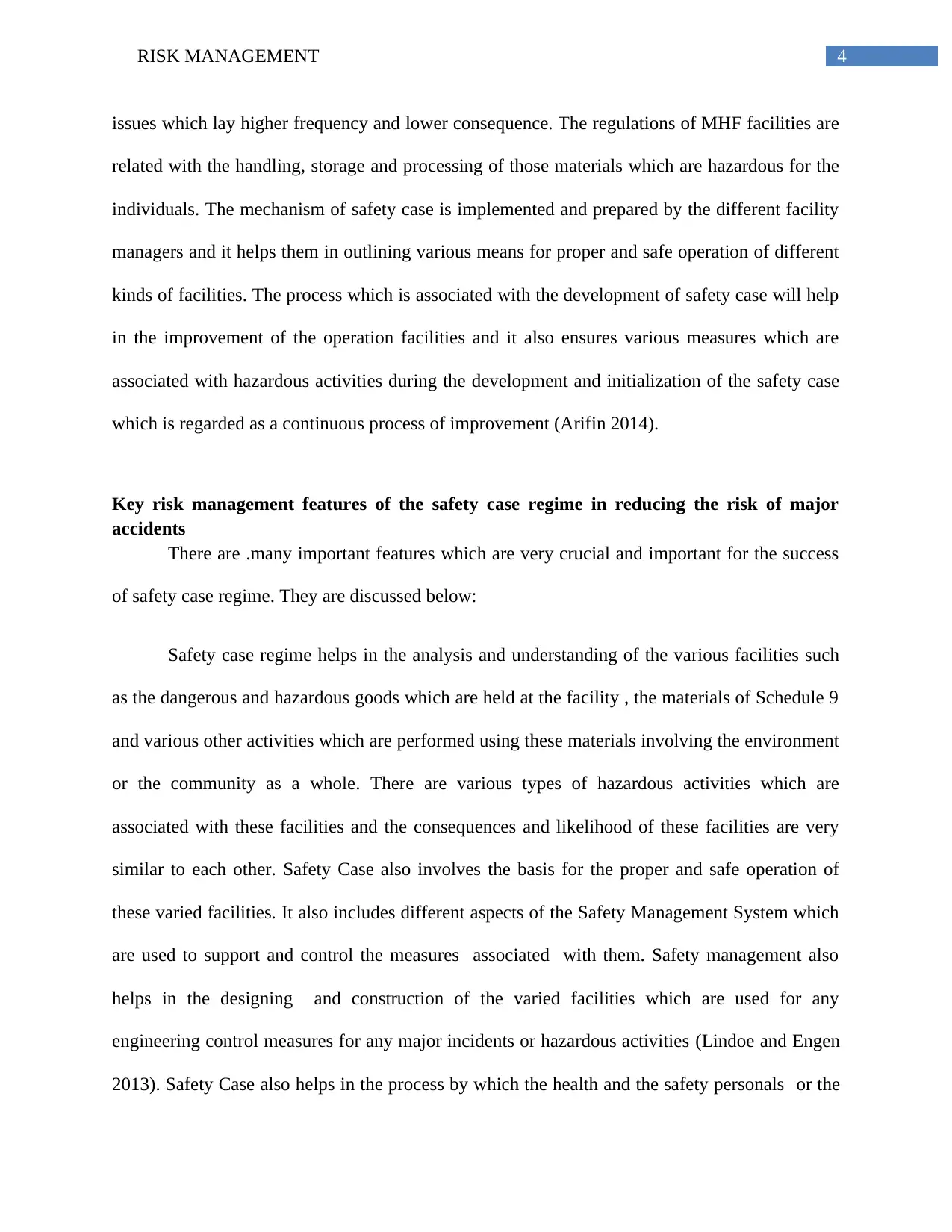
4RISK MANAGEMENT
issues which lay higher frequency and lower consequence. The regulations of MHF facilities are
related with the handling, storage and processing of those materials which are hazardous for the
individuals. The mechanism of safety case is implemented and prepared by the different facility
managers and it helps them in outlining various means for proper and safe operation of different
kinds of facilities. The process which is associated with the development of safety case will help
in the improvement of the operation facilities and it also ensures various measures which are
associated with hazardous activities during the development and initialization of the safety case
which is regarded as a continuous process of improvement (Arifin 2014).
Key risk management features of the safety case regime in reducing the risk of major
accidents
There are .many important features which are very crucial and important for the success
of safety case regime. They are discussed below:
Safety case regime helps in the analysis and understanding of the various facilities such
as the dangerous and hazardous goods which are held at the facility , the materials of Schedule 9
and various other activities which are performed using these materials involving the environment
or the community as a whole. There are various types of hazardous activities which are
associated with these facilities and the consequences and likelihood of these facilities are very
similar to each other. Safety Case also involves the basis for the proper and safe operation of
these varied facilities. It also includes different aspects of the Safety Management System which
are used to support and control the measures associated with them. Safety management also
helps in the designing and construction of the varied facilities which are used for any
engineering control measures for any major incidents or hazardous activities (Lindoe and Engen
2013). Safety Case also helps in the process by which the health and the safety personals or the
issues which lay higher frequency and lower consequence. The regulations of MHF facilities are
related with the handling, storage and processing of those materials which are hazardous for the
individuals. The mechanism of safety case is implemented and prepared by the different facility
managers and it helps them in outlining various means for proper and safe operation of different
kinds of facilities. The process which is associated with the development of safety case will help
in the improvement of the operation facilities and it also ensures various measures which are
associated with hazardous activities during the development and initialization of the safety case
which is regarded as a continuous process of improvement (Arifin 2014).
Key risk management features of the safety case regime in reducing the risk of major
accidents
There are .many important features which are very crucial and important for the success
of safety case regime. They are discussed below:
Safety case regime helps in the analysis and understanding of the various facilities such
as the dangerous and hazardous goods which are held at the facility , the materials of Schedule 9
and various other activities which are performed using these materials involving the environment
or the community as a whole. There are various types of hazardous activities which are
associated with these facilities and the consequences and likelihood of these facilities are very
similar to each other. Safety Case also involves the basis for the proper and safe operation of
these varied facilities. It also includes different aspects of the Safety Management System which
are used to support and control the measures associated with them. Safety management also
helps in the designing and construction of the varied facilities which are used for any
engineering control measures for any major incidents or hazardous activities (Lindoe and Engen
2013). Safety Case also helps in the process by which the health and the safety personals or the

5RISK MANAGEMENT
third parties are involved or are very often consulted for the preparation of the safety case. The
processes used in the safety case will be used in the analysis and review of any safety case
which was previously used. Moreover, the various processes in which the assessments and
procedures of the safety case are described and maintained in accordance with the facility
operation and design. It also includes the technique or manner in varied aspects of safety case
will be designed and integrated for managing the risks and the hazardous activities (Broadribb
2015).
The CSB has set certain key features which are vital for the prevention of some of the
major accidents.
The duty holders safety responsibility involves a written case for the safety
The organization is responsible for the protection and safety of various hazardous
facilities. The main responsibility lies in the duty holder who are the regulator of the company,
the various reasons for selecting one's potential control over another, the different techniques
and methodologies which are used to assess the risk. It is the duty and responsibility of the duty
holder to make arrangements for the written case involving safety. These case must identify the
risks and the hazards and it must also describe how these risk can be minimized to ALARP. The
safety case report also tries to visualize that the duty holder has made there arrangements
properly and if they are implemented they will be able to reach those compliance with the other
legal objectives (Sabel, Herrigel and Kristensen 2014). Moreover, it is also vital that the safety
case must serve as an evergreen document which will help to highlight the improvements in the
reduction of hazardous activities. In the onshore operational case, it is the responsibility of the
duty holder to check the safety report for starting any new construction projects. These will be in
improving the technical knowledge and new facts about the safety management system. The duty
third parties are involved or are very often consulted for the preparation of the safety case. The
processes used in the safety case will be used in the analysis and review of any safety case
which was previously used. Moreover, the various processes in which the assessments and
procedures of the safety case are described and maintained in accordance with the facility
operation and design. It also includes the technique or manner in varied aspects of safety case
will be designed and integrated for managing the risks and the hazardous activities (Broadribb
2015).
The CSB has set certain key features which are vital for the prevention of some of the
major accidents.
The duty holders safety responsibility involves a written case for the safety
The organization is responsible for the protection and safety of various hazardous
facilities. The main responsibility lies in the duty holder who are the regulator of the company,
the various reasons for selecting one's potential control over another, the different techniques
and methodologies which are used to assess the risk. It is the duty and responsibility of the duty
holder to make arrangements for the written case involving safety. These case must identify the
risks and the hazards and it must also describe how these risk can be minimized to ALARP. The
safety case report also tries to visualize that the duty holder has made there arrangements
properly and if they are implemented they will be able to reach those compliance with the other
legal objectives (Sabel, Herrigel and Kristensen 2014). Moreover, it is also vital that the safety
case must serve as an evergreen document which will help to highlight the improvements in the
reduction of hazardous activities. In the onshore operational case, it is the responsibility of the
duty holder to check the safety report for starting any new construction projects. These will be in
improving the technical knowledge and new facts about the safety management system. The duty
⊘ This is a preview!⊘
Do you want full access?
Subscribe today to unlock all pages.

Trusted by 1+ million students worldwide

6RISK MANAGEMENT
holders must also update and revise the safety report to provide a proper guideline in times of
major accidents. The regulator must also accept the report of the so that he can start the
operation process or continue the same process. However, it must be noted that mere acceptance
of the safety report by the regulator does not help in the installation or license. It is the
responsibility of the duty holder to ensure that installation process must be carried out in
accordance with the rules and procedures laid down by the management.
Continuous Risk Reduction associated with ALARP
The principle of ALARP help the regulator in the foundation to accept or deny the safety
report. It is the duty of the regulator to check whether the ALARP has been successfully
achieved with the help of the authority or not. ALARP also helps in the reduction of risk to keep
it updated with the latest technology. It is also important for the regulator to accept the
application of good practices and this will help in the demonstration of ALARP (Chappel 2016).
Adaptability and Improvement
Safety case regulatory regime helps the regulator in the improvement of various facilities
and thus it will also help in ensuring the risks which are associated with the reduction of
ALARP. It will also help to focus the various activities which are based on varied regulatory
requirements. The regulator must also have the ability in helping the facilities in going beyond
the standards and thus it will help in achieving the ALARP without any particular rules and
regulations (Sujan et al 2016). The processes which are associated with the regulation of safety
will be the same for certain decades. There are also certain problems which are closely
associated in maintaining the aging and the safety equipments and this helps to know whether the
safety cases are operating properly or not. HSE has made different kinds of efforts to make
improvement in its area of operation (Silye and Authority 2014).
holders must also update and revise the safety report to provide a proper guideline in times of
major accidents. The regulator must also accept the report of the so that he can start the
operation process or continue the same process. However, it must be noted that mere acceptance
of the safety report by the regulator does not help in the installation or license. It is the
responsibility of the duty holder to ensure that installation process must be carried out in
accordance with the rules and procedures laid down by the management.
Continuous Risk Reduction associated with ALARP
The principle of ALARP help the regulator in the foundation to accept or deny the safety
report. It is the duty of the regulator to check whether the ALARP has been successfully
achieved with the help of the authority or not. ALARP also helps in the reduction of risk to keep
it updated with the latest technology. It is also important for the regulator to accept the
application of good practices and this will help in the demonstration of ALARP (Chappel 2016).
Adaptability and Improvement
Safety case regulatory regime helps the regulator in the improvement of various facilities
and thus it will also help in ensuring the risks which are associated with the reduction of
ALARP. It will also help to focus the various activities which are based on varied regulatory
requirements. The regulator must also have the ability in helping the facilities in going beyond
the standards and thus it will help in achieving the ALARP without any particular rules and
regulations (Sujan et al 2016). The processes which are associated with the regulation of safety
will be the same for certain decades. There are also certain problems which are closely
associated in maintaining the aging and the safety equipments and this helps to know whether the
safety cases are operating properly or not. HSE has made different kinds of efforts to make
improvement in its area of operation (Silye and Authority 2014).
Paraphrase This Document
Need a fresh take? Get an instant paraphrase of this document with our AI Paraphraser
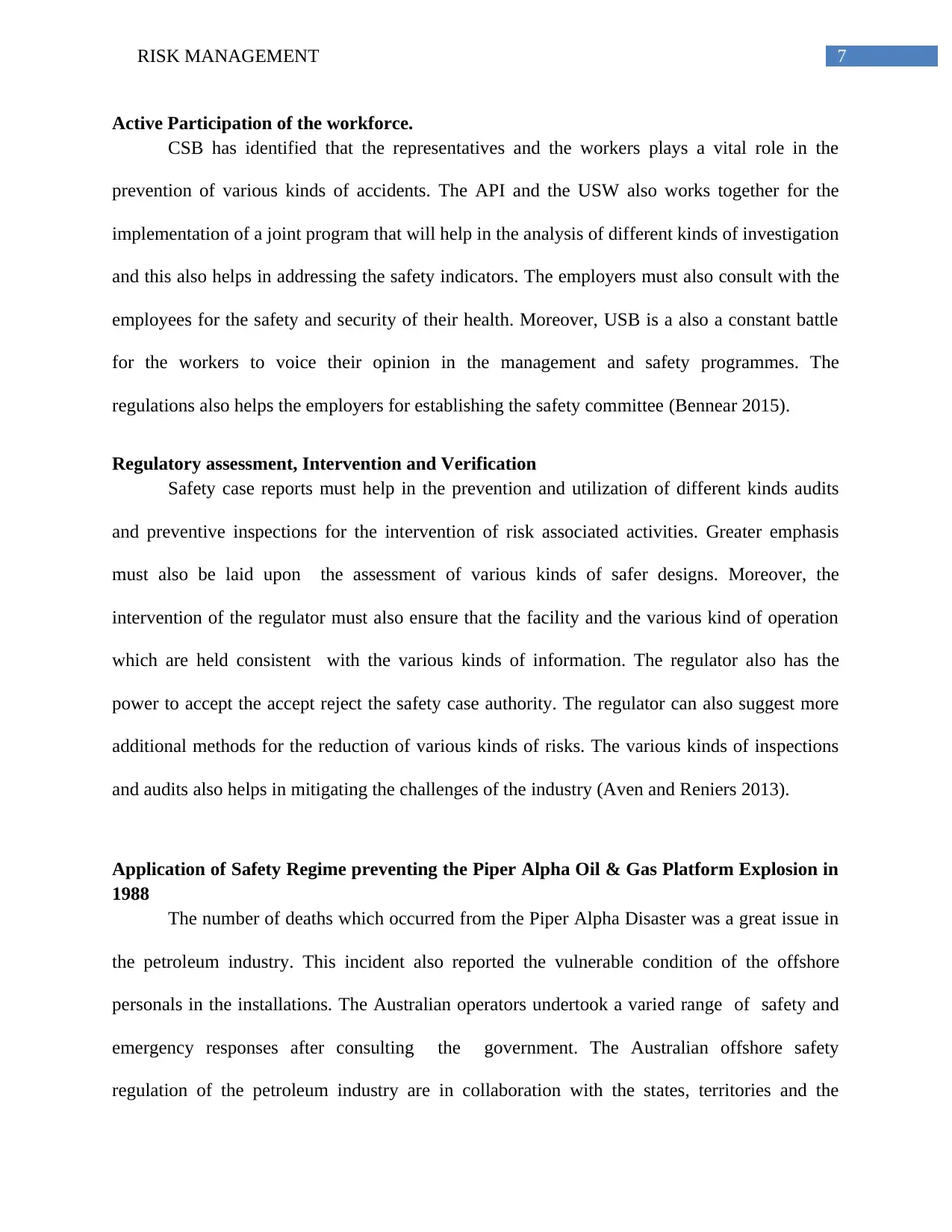
7RISK MANAGEMENT
Active Participation of the workforce.
CSB has identified that the representatives and the workers plays a vital role in the
prevention of various kinds of accidents. The API and the USW also works together for the
implementation of a joint program that will help in the analysis of different kinds of investigation
and this also helps in addressing the safety indicators. The employers must also consult with the
employees for the safety and security of their health. Moreover, USB is a also a constant battle
for the workers to voice their opinion in the management and safety programmes. The
regulations also helps the employers for establishing the safety committee (Bennear 2015).
Regulatory assessment, Intervention and Verification
Safety case reports must help in the prevention and utilization of different kinds audits
and preventive inspections for the intervention of risk associated activities. Greater emphasis
must also be laid upon the assessment of various kinds of safer designs. Moreover, the
intervention of the regulator must also ensure that the facility and the various kind of operation
which are held consistent with the various kinds of information. The regulator also has the
power to accept the accept reject the safety case authority. The regulator can also suggest more
additional methods for the reduction of various kinds of risks. The various kinds of inspections
and audits also helps in mitigating the challenges of the industry (Aven and Reniers 2013).
Application of Safety Regime preventing the Piper Alpha Oil & Gas Platform Explosion in
1988
The number of deaths which occurred from the Piper Alpha Disaster was a great issue in
the petroleum industry. This incident also reported the vulnerable condition of the offshore
personals in the installations. The Australian operators undertook a varied range of safety and
emergency responses after consulting the government. The Australian offshore safety
regulation of the petroleum industry are in collaboration with the states, territories and the
Active Participation of the workforce.
CSB has identified that the representatives and the workers plays a vital role in the
prevention of various kinds of accidents. The API and the USW also works together for the
implementation of a joint program that will help in the analysis of different kinds of investigation
and this also helps in addressing the safety indicators. The employers must also consult with the
employees for the safety and security of their health. Moreover, USB is a also a constant battle
for the workers to voice their opinion in the management and safety programmes. The
regulations also helps the employers for establishing the safety committee (Bennear 2015).
Regulatory assessment, Intervention and Verification
Safety case reports must help in the prevention and utilization of different kinds audits
and preventive inspections for the intervention of risk associated activities. Greater emphasis
must also be laid upon the assessment of various kinds of safer designs. Moreover, the
intervention of the regulator must also ensure that the facility and the various kind of operation
which are held consistent with the various kinds of information. The regulator also has the
power to accept the accept reject the safety case authority. The regulator can also suggest more
additional methods for the reduction of various kinds of risks. The various kinds of inspections
and audits also helps in mitigating the challenges of the industry (Aven and Reniers 2013).
Application of Safety Regime preventing the Piper Alpha Oil & Gas Platform Explosion in
1988
The number of deaths which occurred from the Piper Alpha Disaster was a great issue in
the petroleum industry. This incident also reported the vulnerable condition of the offshore
personals in the installations. The Australian operators undertook a varied range of safety and
emergency responses after consulting the government. The Australian offshore safety
regulation of the petroleum industry are in collaboration with the states, territories and the
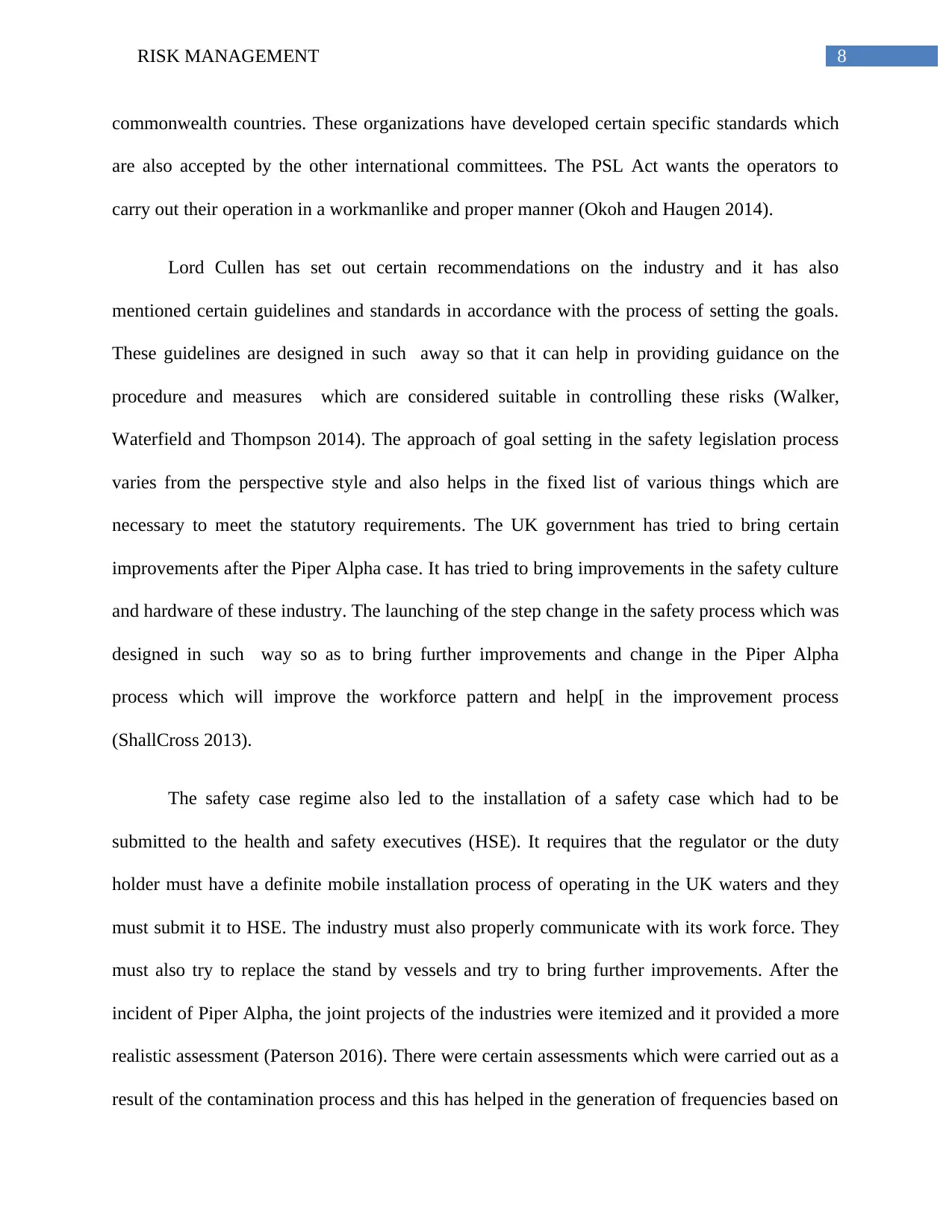
8RISK MANAGEMENT
commonwealth countries. These organizations have developed certain specific standards which
are also accepted by the other international committees. The PSL Act wants the operators to
carry out their operation in a workmanlike and proper manner (Okoh and Haugen 2014).
Lord Cullen has set out certain recommendations on the industry and it has also
mentioned certain guidelines and standards in accordance with the process of setting the goals.
These guidelines are designed in such away so that it can help in providing guidance on the
procedure and measures which are considered suitable in controlling these risks (Walker,
Waterfield and Thompson 2014). The approach of goal setting in the safety legislation process
varies from the perspective style and also helps in the fixed list of various things which are
necessary to meet the statutory requirements. The UK government has tried to bring certain
improvements after the Piper Alpha case. It has tried to bring improvements in the safety culture
and hardware of these industry. The launching of the step change in the safety process which was
designed in such way so as to bring further improvements and change in the Piper Alpha
process which will improve the workforce pattern and help[ in the improvement process
(ShallCross 2013).
The safety case regime also led to the installation of a safety case which had to be
submitted to the health and safety executives (HSE). It requires that the regulator or the duty
holder must have a definite mobile installation process of operating in the UK waters and they
must submit it to HSE. The industry must also properly communicate with its work force. They
must also try to replace the stand by vessels and try to bring further improvements. After the
incident of Piper Alpha, the joint projects of the industries were itemized and it provided a more
realistic assessment (Paterson 2016). There were certain assessments which were carried out as a
result of the contamination process and this has helped in the generation of frequencies based on
commonwealth countries. These organizations have developed certain specific standards which
are also accepted by the other international committees. The PSL Act wants the operators to
carry out their operation in a workmanlike and proper manner (Okoh and Haugen 2014).
Lord Cullen has set out certain recommendations on the industry and it has also
mentioned certain guidelines and standards in accordance with the process of setting the goals.
These guidelines are designed in such away so that it can help in providing guidance on the
procedure and measures which are considered suitable in controlling these risks (Walker,
Waterfield and Thompson 2014). The approach of goal setting in the safety legislation process
varies from the perspective style and also helps in the fixed list of various things which are
necessary to meet the statutory requirements. The UK government has tried to bring certain
improvements after the Piper Alpha case. It has tried to bring improvements in the safety culture
and hardware of these industry. The launching of the step change in the safety process which was
designed in such way so as to bring further improvements and change in the Piper Alpha
process which will improve the workforce pattern and help[ in the improvement process
(ShallCross 2013).
The safety case regime also led to the installation of a safety case which had to be
submitted to the health and safety executives (HSE). It requires that the regulator or the duty
holder must have a definite mobile installation process of operating in the UK waters and they
must submit it to HSE. The industry must also properly communicate with its work force. They
must also try to replace the stand by vessels and try to bring further improvements. After the
incident of Piper Alpha, the joint projects of the industries were itemized and it provided a more
realistic assessment (Paterson 2016). There were certain assessments which were carried out as a
result of the contamination process and this has helped in the generation of frequencies based on
⊘ This is a preview!⊘
Do you want full access?
Subscribe today to unlock all pages.

Trusted by 1+ million students worldwide
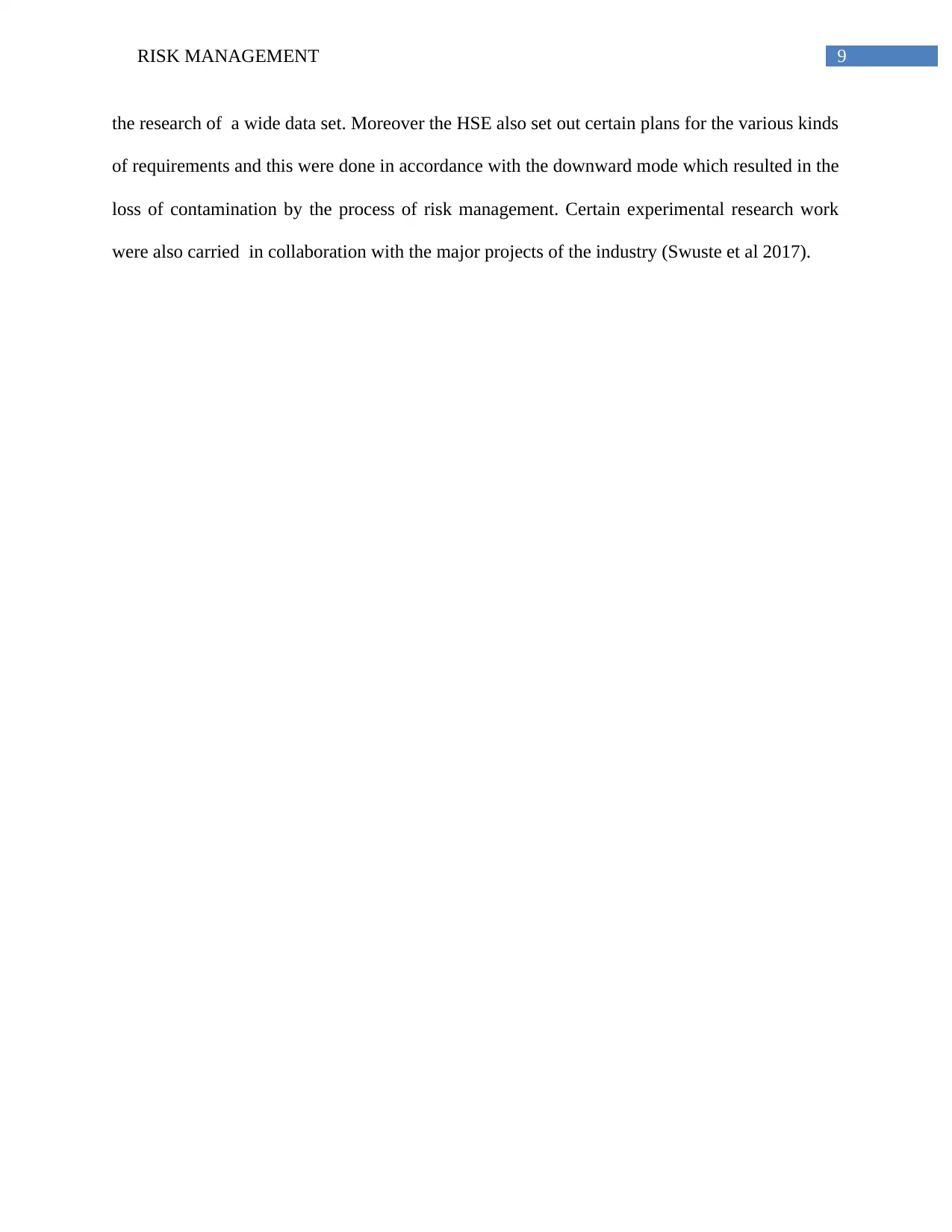
9RISK MANAGEMENT
the research of a wide data set. Moreover the HSE also set out certain plans for the various kinds
of requirements and this were done in accordance with the downward mode which resulted in the
loss of contamination by the process of risk management. Certain experimental research work
were also carried in collaboration with the major projects of the industry (Swuste et al 2017).
the research of a wide data set. Moreover the HSE also set out certain plans for the various kinds
of requirements and this were done in accordance with the downward mode which resulted in the
loss of contamination by the process of risk management. Certain experimental research work
were also carried in collaboration with the major projects of the industry (Swuste et al 2017).
Paraphrase This Document
Need a fresh take? Get an instant paraphrase of this document with our AI Paraphraser
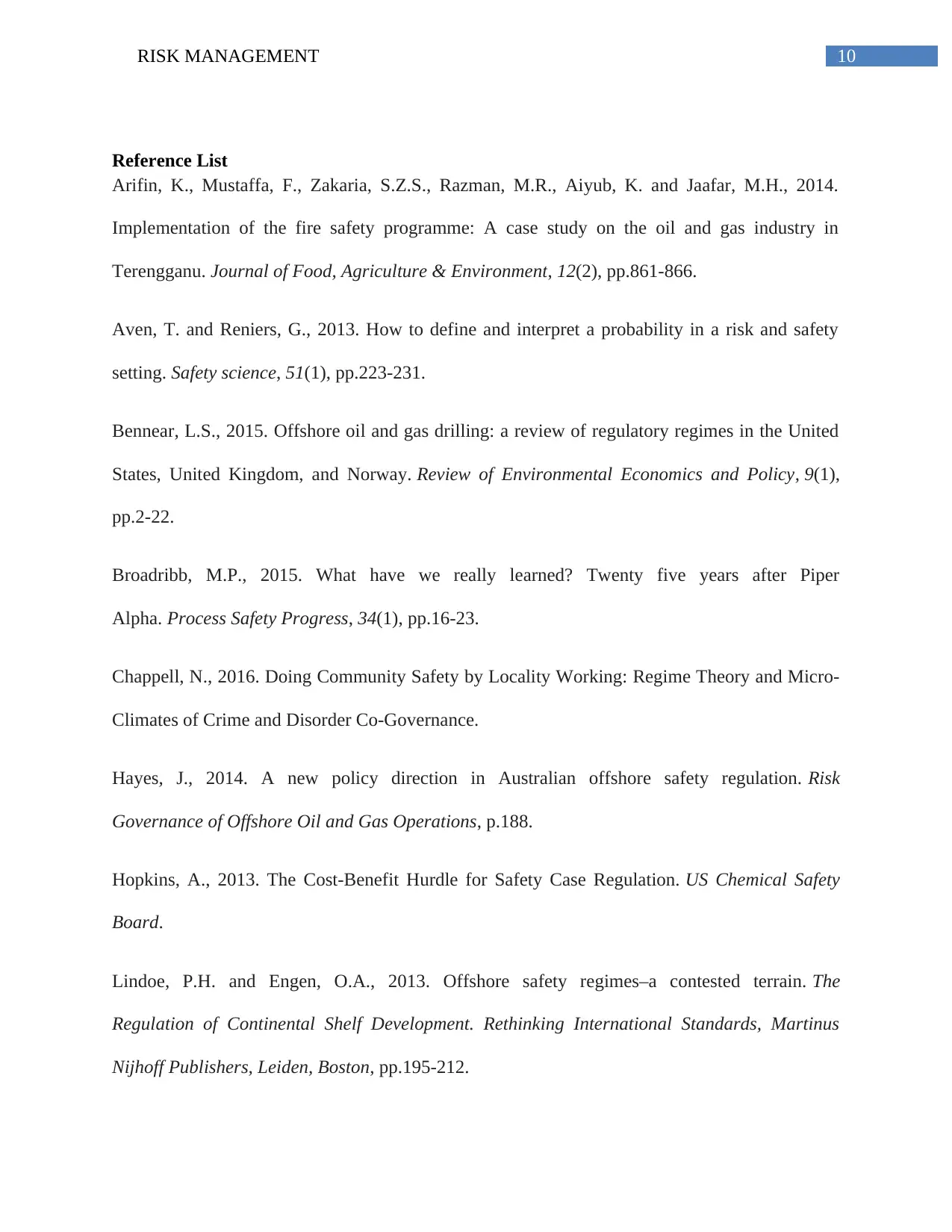
10RISK MANAGEMENT
Reference List
Arifin, K., Mustaffa, F., Zakaria, S.Z.S., Razman, M.R., Aiyub, K. and Jaafar, M.H., 2014.
Implementation of the fire safety programme: A case study on the oil and gas industry in
Terengganu. Journal of Food, Agriculture & Environment, 12(2), pp.861-866.
Aven, T. and Reniers, G., 2013. How to define and interpret a probability in a risk and safety
setting. Safety science, 51(1), pp.223-231.
Bennear, L.S., 2015. Offshore oil and gas drilling: a review of regulatory regimes in the United
States, United Kingdom, and Norway. Review of Environmental Economics and Policy, 9(1),
pp.2-22.
Broadribb, M.P., 2015. What have we really learned? Twenty five years after Piper
Alpha. Process Safety Progress, 34(1), pp.16-23.
Chappell, N., 2016. Doing Community Safety by Locality Working: Regime Theory and Micro-
Climates of Crime and Disorder Co-Governance.
Hayes, J., 2014. A new policy direction in Australian offshore safety regulation. Risk
Governance of Offshore Oil and Gas Operations, p.188.
Hopkins, A., 2013. The Cost-Benefit Hurdle for Safety Case Regulation. US Chemical Safety
Board.
Lindoe, P.H. and Engen, O.A., 2013. Offshore safety regimes–a contested terrain. The
Regulation of Continental Shelf Development. Rethinking International Standards, Martinus
Nijhoff Publishers, Leiden, Boston, pp.195-212.
Reference List
Arifin, K., Mustaffa, F., Zakaria, S.Z.S., Razman, M.R., Aiyub, K. and Jaafar, M.H., 2014.
Implementation of the fire safety programme: A case study on the oil and gas industry in
Terengganu. Journal of Food, Agriculture & Environment, 12(2), pp.861-866.
Aven, T. and Reniers, G., 2013. How to define and interpret a probability in a risk and safety
setting. Safety science, 51(1), pp.223-231.
Bennear, L.S., 2015. Offshore oil and gas drilling: a review of regulatory regimes in the United
States, United Kingdom, and Norway. Review of Environmental Economics and Policy, 9(1),
pp.2-22.
Broadribb, M.P., 2015. What have we really learned? Twenty five years after Piper
Alpha. Process Safety Progress, 34(1), pp.16-23.
Chappell, N., 2016. Doing Community Safety by Locality Working: Regime Theory and Micro-
Climates of Crime and Disorder Co-Governance.
Hayes, J., 2014. A new policy direction in Australian offshore safety regulation. Risk
Governance of Offshore Oil and Gas Operations, p.188.
Hopkins, A., 2013. The Cost-Benefit Hurdle for Safety Case Regulation. US Chemical Safety
Board.
Lindoe, P.H. and Engen, O.A., 2013. Offshore safety regimes–a contested terrain. The
Regulation of Continental Shelf Development. Rethinking International Standards, Martinus
Nijhoff Publishers, Leiden, Boston, pp.195-212.
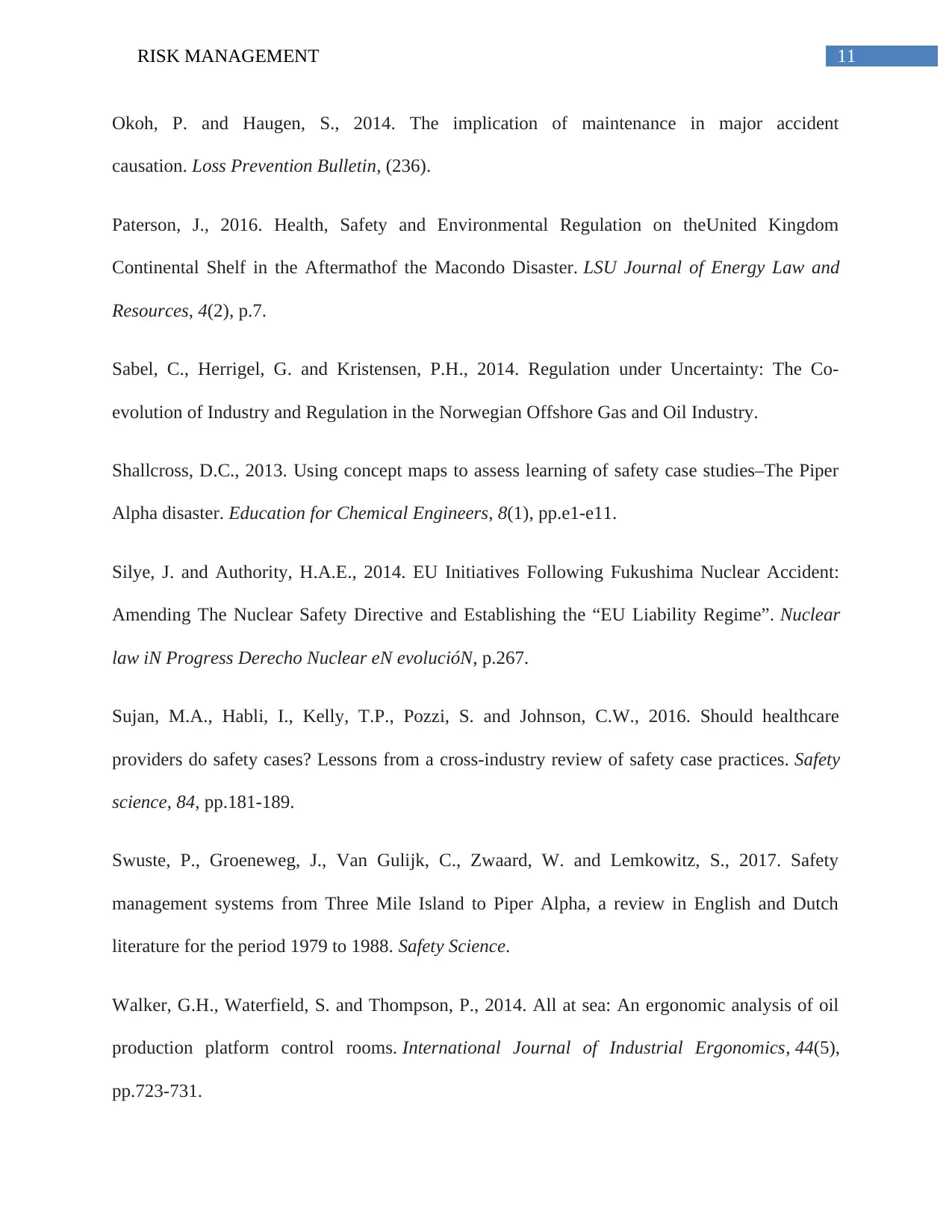
11RISK MANAGEMENT
Okoh, P. and Haugen, S., 2014. The implication of maintenance in major accident
causation. Loss Prevention Bulletin, (236).
Paterson, J., 2016. Health, Safety and Environmental Regulation on theUnited Kingdom
Continental Shelf in the Aftermathof the Macondo Disaster. LSU Journal of Energy Law and
Resources, 4(2), p.7.
Sabel, C., Herrigel, G. and Kristensen, P.H., 2014. Regulation under Uncertainty: The Co-
evolution of Industry and Regulation in the Norwegian Offshore Gas and Oil Industry.
Shallcross, D.C., 2013. Using concept maps to assess learning of safety case studies–The Piper
Alpha disaster. Education for Chemical Engineers, 8(1), pp.e1-e11.
Silye, J. and Authority, H.A.E., 2014. EU Initiatives Following Fukushima Nuclear Accident:
Amending The Nuclear Safety Directive and Establishing the “EU Liability Regime”. Nuclear
law iN Progress Derecho Nuclear eN evolucióN, p.267.
Sujan, M.A., Habli, I., Kelly, T.P., Pozzi, S. and Johnson, C.W., 2016. Should healthcare
providers do safety cases? Lessons from a cross-industry review of safety case practices. Safety
science, 84, pp.181-189.
Swuste, P., Groeneweg, J., Van Gulijk, C., Zwaard, W. and Lemkowitz, S., 2017. Safety
management systems from Three Mile Island to Piper Alpha, a review in English and Dutch
literature for the period 1979 to 1988. Safety Science.
Walker, G.H., Waterfield, S. and Thompson, P., 2014. All at sea: An ergonomic analysis of oil
production platform control rooms. International Journal of Industrial Ergonomics, 44(5),
pp.723-731.
Okoh, P. and Haugen, S., 2014. The implication of maintenance in major accident
causation. Loss Prevention Bulletin, (236).
Paterson, J., 2016. Health, Safety and Environmental Regulation on theUnited Kingdom
Continental Shelf in the Aftermathof the Macondo Disaster. LSU Journal of Energy Law and
Resources, 4(2), p.7.
Sabel, C., Herrigel, G. and Kristensen, P.H., 2014. Regulation under Uncertainty: The Co-
evolution of Industry and Regulation in the Norwegian Offshore Gas and Oil Industry.
Shallcross, D.C., 2013. Using concept maps to assess learning of safety case studies–The Piper
Alpha disaster. Education for Chemical Engineers, 8(1), pp.e1-e11.
Silye, J. and Authority, H.A.E., 2014. EU Initiatives Following Fukushima Nuclear Accident:
Amending The Nuclear Safety Directive and Establishing the “EU Liability Regime”. Nuclear
law iN Progress Derecho Nuclear eN evolucióN, p.267.
Sujan, M.A., Habli, I., Kelly, T.P., Pozzi, S. and Johnson, C.W., 2016. Should healthcare
providers do safety cases? Lessons from a cross-industry review of safety case practices. Safety
science, 84, pp.181-189.
Swuste, P., Groeneweg, J., Van Gulijk, C., Zwaard, W. and Lemkowitz, S., 2017. Safety
management systems from Three Mile Island to Piper Alpha, a review in English and Dutch
literature for the period 1979 to 1988. Safety Science.
Walker, G.H., Waterfield, S. and Thompson, P., 2014. All at sea: An ergonomic analysis of oil
production platform control rooms. International Journal of Industrial Ergonomics, 44(5),
pp.723-731.
⊘ This is a preview!⊘
Do you want full access?
Subscribe today to unlock all pages.

Trusted by 1+ million students worldwide
1 out of 12
Related Documents
Your All-in-One AI-Powered Toolkit for Academic Success.
+13062052269
info@desklib.com
Available 24*7 on WhatsApp / Email
![[object Object]](/_next/static/media/star-bottom.7253800d.svg)
Unlock your academic potential
Copyright © 2020–2025 A2Z Services. All Rights Reserved. Developed and managed by ZUCOL.





